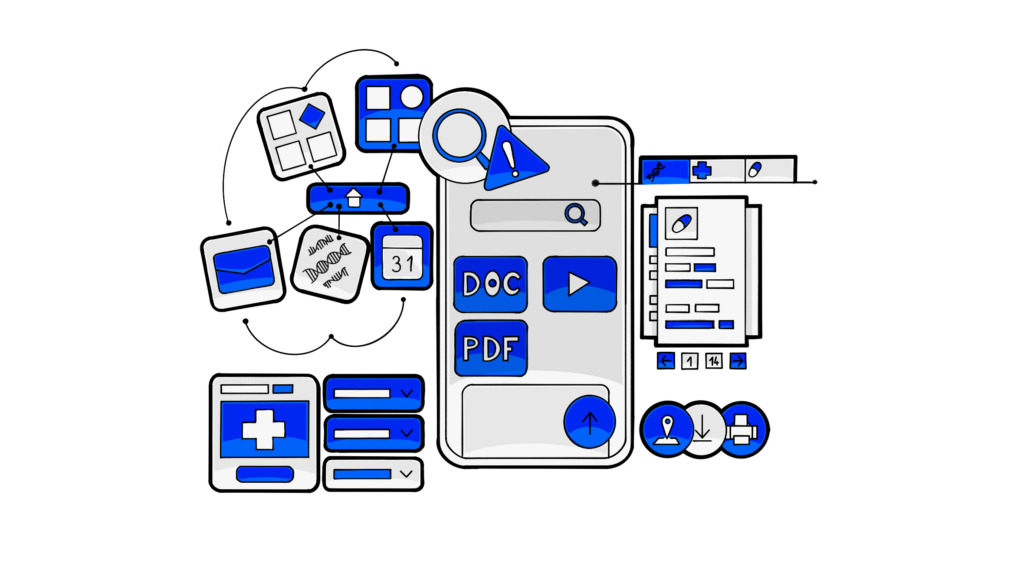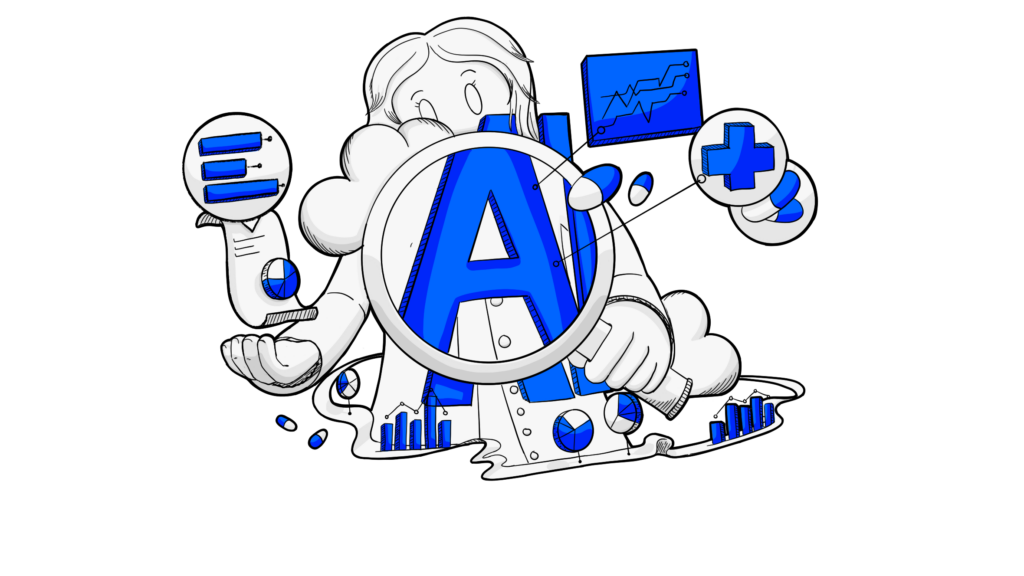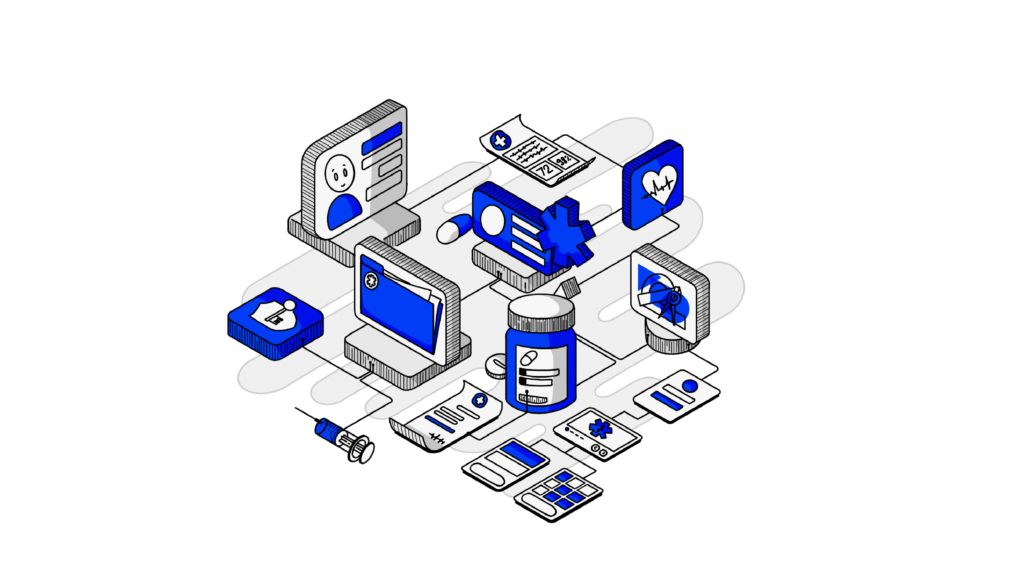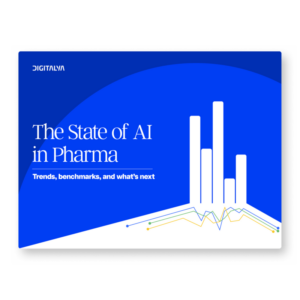Omnichannel healthcare strategy seems to be the buzz of the past years, together with omnichannel customer service strategy. Still, the concept has been on the agenda of various businesses, especially in retail, ahead of the COVID-19 pandemic and its implications regarding the mass digitalization of services.
1. Introduction
When did omnichannel start? The omnichannel concept was introduced in 2010 to describe the expansion of the customer experience beyond the multi-channel approach. The omnichannel strategy benefits for retailers were pointed out in a study back in 2017. So, what about the healthcare system? Is it now the right time to consider an omnichannel healthcare strategy?
1.1 Why do you need an intelligent omnichannel healthcare strategy?
Why would healthcare organizations and institutions make an effort to adopt a strategy devised primarily for retail marketing? The answer is in the healthcare system’s very Why: the customers’ well-being (in most cases, the patients). The benefits of an omnichannel strategy, no matter the industry, translate into a better customer experience. In healthcare, improved experience for beneficiaries and professionals has even more implications than in any other domain. It can translate into better health, safety, and improved quality of life.
2. Understanding omnichannel in healthcare
Before talking more about omnichannel healthcare strategy, let’s better grasp its meaning, the benefits of healthcare, and what to watch for.
2.1 Defining the concept of omnichannel in healthcare
Multichannel is probably a more familiar term, so you may ask yourselves how they differ. Both terms talk about a customer approach on several communication and distribution channels. An omnichannel strategy encompasses a multichannel approach. The omnichannel concept refers to a broader perspective, focusing on the entire customer journey.
What is omnichannel healthcare, more precisely? It refers to all the interactions between healthcare consumers and healthcare providers, comprising direct communication, information, and recommendations via in-person interactions combined with self-service experiences and digital channels.
2.2 What are the benefits of an omnichannel approach in healthcare?
Acting on so many fronts to meet healthcare customers requires a lot of time and finances. So, a natural question is why omnichannel is essential and why to invest in an omnichannel healthcare strategy.
Let’s look at the main benefits:
- Increased efficiency for healthcare providers
When the customer journey (patients are, in the end, customers of the healthcare system) involves multiple channels to serve the same purpose, you can easily distribute tasks between healthcare providers, algorithms, and customers. Therefore, you achieve more in less time.
- Reduced health risks
An omnichannel healthcare approach ensures more accurate and rigorous follow-up for patient engagement, especially after medical interventions. Close, real-time observation reduces the risk of complications, enforces preventive care, and can reduce the rate of readmissions.
- Smoother workflows
Access to data and patient information can ease flows within healthcare organizations, improving intervention times and saving precious hours for professionals. Self-service solutions for hospital admissions or paying the bills, for example, with online appointments, are important time savers, as trivial as they may seem.
- Happier customers
Let’s face it; when we talk about omnichannel marketing, healthcare is no exception in terms of general objective: gaining satisfied clients who will happily return to your services. The better experience within the consumer journey, the more likely they are to choose your products and services again. Medical omnichannel makes the medical experience smoother and friendlier, with better outcomes for all parts involved, not only the patients.
2.3 Challenges and considerations in implementing an omnichannel strategy
Still, we should stay grounded and not idealize the omnichannel healthcare strategy by completely disregarding its challenges.
First and foremost, we need to acknowledge that the greatest need for an omnichannel strategy in healthcare comes from hospitals. But hospitals are complex institutions known for their inertia to adopting new technologies. While the pandemic has accelerated change substantially, omnichannel health involves a new level of organizing workflows, and protocols, training staff, implementing hardware and software, etc., even for the first level of omnichannel medical communications.
As mentioned before, the very omnichannel strategy definition implies an approach that covers all channels involved in the customer journey. Thus, when it comes to omnichannel strategy, McKinsey warns about effective resource distribution: where to start? which channel to prioritize?
Another possible threat is the risk of losing focus on the value brought to the healthcare consumer while concentrating too much on the technical details. After implementing the digital solutions, this may become evident only in the end when it becomes clear that the investment does not translate into the expected customer/ patient satisfaction.
The adoption of healthcare omnichannel solutions by the medical and non-medical staff, as well as by the patients, is a relevant challenge. Like any novelty, you should consider the learning curve and the natural inhibition towards adopting a new tool and behavior. Otherwise, you might not meet the end purpose – improving the experience of the medical act for everybody – no matter how smart the technologies involved across all channels.
When we talk about ehealthcare strategy and trends, we inevitably talk about AI and processing large amounts of health data. This, in turn, raises concerns regarding transparency versus privacy. Compliance with government regulations is mandatory when the omnichannel strategy healthcare is involved.
3. Building a smart omnichannel healthcare strategy
The benefits are pretty clear when talking about omnichannel healthcare, but the path to getting there may seem complicated and overwhelming. As in the case of any change process, a smart, down-to-earth strategy is the key. So, what is an omni-channel strategy but an omnichannel strategy framework that sets the directions for how the patients, healthcare professionals, and organizations will interact across all channels with minimal effort but maximum benefit?
3.1 Key components of an omnichannel healthcare strategy
In short, the main components of a strategy are people, means, and processes. In healthcare, these elements can be further regarded from the specificity point of view.
- People
Who are the people in a healthcare omnichannel approach? The main focus is on patients – this is why such a strategy is considered in the first place. But to improve the patients’ experience across all channels involves improving workflows and experiences for all the other parties involved: medical professionals, health care personnel, administrative and support staff, and even the patients’ families. All these actors need to be mapped; their position and role in the “customer journey” has to be identified clearly and linked to all the interaction channels available.
- Means
In our case, the means are the channels we talk about, mainly interactive platforms that allow smooth interactions and task-solving for various medical service actors. We talk about telemedicine platforms, self-service apps for patients, real-time monitoring or cross-discipline data sharing within a hospital, and even pharma omnichannel platforms.
- Processes
Hospitals and medical institutions have spent a great amount of time defining protocols that would increase safety and improve the medical act. The same protocols need to be designed for the interactions involving the people and means (platforms) in the strategy.
You must prioritize these elements, however, and deal with them step by step, with clear objectives, omnichannel KPIs to measure success, and a realistic allocation of resources – people, money, and time.
3.2 How can you use technology to create an omnichannel strategy?
Improving patient healthcare experience within an omnichannel approach requires a consumer-driven healthcare model that is both cost-effective and patient satisfaction oriented.
The technology used in healthcare app development plays an important role in implementing an omnichannel strategy. Omnichannel communication is a challenge, but it is achievable thanks to the latest advancement in programming, artificial intelligence (AI), machine learning, or IoT. Some other examples of the use of technology for omnichannel healthcare are the automation of recurrent tasks, both on the patients’ and the medical staff’s side, online registrations and payments, chatbots, or digital education.
Digital health may go beyond consulting EMRs (electronic medical records) to establish the diagnosis, lines of treatment, or potential risks. They could use technology (AI in particular) to meet patients on social media or other channels patients prefer to assess care delivery: possible causes for illness and the best ways for healthcare delivery.
3.3 Case studies of successful smart omnichannel healthcare implementations
When it comes to implementing an omnichannel strategy pharma looks to be quite ahead of other healthcare areas. Pharma omnichannel engagement is one of the most used examples of healthcare marketing, with results that confirm its efficiency.
We have a good example of a healthcare omnichannel platform developed for a large German pharma company. It aimed to provide relevant information for professionals and the general public while improving their healthcare marketing and sales efforts. The omnichannel platform unified the roles that the existing website, web application, and platforms played, adding social sharing components as digital front doors.
The success of this healthcare omnichannel platform translated into a patient journey and an omnichannel engagement between medical professionals and their patients, thanks to the information sharing across all channels involved.
The search engine optimizations made it possible for medical information available within the platform to be much easier to discover and access, while the platform, itself, ranked higher in search results.
Another good example of a smart omnichannel healthcare strategy in a hospital is a post-intervention scenario.
If you have someone close who underwent surgery, you may be familiar with the post-up procedures upon discharge. Hospitals that still employ the classical methods send their patients home with an entire dossier and paper instructions and recipes for medication.
Then, it is up to the patient to run through those documents, understand and remember what to do, which pills to take first, from where, etc.
The risk of missing something is rather high, which implies calls to the doctor for reminders and further explanations and, in the worst-case scenario, readmission for failing to follow the proper post-op care actions.
Now, imagine a hospital that implements an omnichannel strategy.
First of all, the patient goes home with no paperwork. He can deal with the bill or insurance claim online, on the platform. The patient opted to communicate via text messages, phone calls, portals, and email.
Now, his data is converted into actionable insights across the entire care continuum.
It will go like this: a nurse calls to check on the patient the day after the surgery. A text message informs him that the prescription is ready for pick up. If our digital patient fails to pick it up, the nurse returns with a new phone call, explaining the importance of getting the medication on time. He receives instructions for taking the medication via email and reminders for following medical check-ups. He connects his email to the calendar, so the appointments are automatically registered in the calendar with respective reminders.
4. The role of AI in next-generation healthcare
The examples of the omnichannel strategy described above are just the beginning of what you can achieve in healthcare with the help of technology, an omnichannel strategy, and a serious healthcare development company. Next-generation healthcare will rely heavily on AI as an improved agent for virtual care. The first steps have already been made, looking very promising.
4.1 How is AI useful in healthcare?
As mentioned above, AI’s major role in healthcare is due to its ability to process large amounts of data. The better the data management and interpretation, the more understanding medical professionals have of disease causes, risk factors, and clinical outcomes.
AI is extremely important for consumer-driven healthcare. It helps to establish a correct diagnosis and customized lines of treatment. AI can also play a crucial role in prevention by analyzing big data sets that can indicate far in advance the risk of certain diseases or conditions.
4.2 What are some applications of AI in your omnichannel strategy?
Within an omnichannel strategy, the benefit of AI is mainly its capacity to leverage data. This, in turn, enables scaling and fast information distribution across omnichannel systems.
You can get real-time, accurate insights into patients’ expectations, preferences, or behaviors to improve your healthcare offer. You can meet patients on digital channels with relevant information and reminders that will boost engagement in healthcare.
For example, by employing AI and machine learning in healthcare, you can learn which patient prefers an in-person approach and who is more comfortable with online communications.
With AI, some patients can check their symptoms online before talking to a medical professional. When this interaction eventually occurs, the patient will have a clearer understanding of what happens and what needs further discussion. On the other end, the medical professional has already received a first assessment of the patient based on an online symptoms check.
4.3 Ethical concerns in using AI in healthcare
As in the case of all AI implementations, there will always be ethical and legal concerns. Dealing with data, in general, is a sensitive matter; leveraging data in healthcare is even more delicate.
Before starting your research on implementing artificial intelligence in your omnichannel healthcare strategy, check the compliance requirements and regulations you must abide by. They may differ from country to country. In the U.S., for instance, there is HIPAA compliance in place. In Europe, the privacy of data is protected by GDPR compliance. There is also a comprehensive guideline on “Ethics and governance of artificial intelligence for health” issued by the World Health Organisation.
Having access to private, sensitive data and giving access to it to various parties raises legitimate, ethical questions. Although the purpose is to serve people to improve their health and quality of life, things can always go wrong and have the opposite effect. Denying technology because of this risk is not a solution, though. Taking all the precautions against negative outcomes is the only way to make AI work in an unharmful context.
5. Challenges and opportunities in implementing an omnichannel strategy
Any new business approach comes with plenty of opportunities, but it equally brings some challenges. Once you are aware of them, you can easily concentrate on seizing the opportunity and overcoming the challenges.
5.1 Common challenges faced in omnichannel healthcare strategies
- Data synchronization and sharing
Just like in other omnichannel experiences, the strategy’s success depends much on how well data is transmitted, in real-time, across all the channels. It is not easy for simpler organizational models such as retailers; imagine how complex it becomes for a clinic or hospital. Still, if the processes are well thought-through and prioritized, it can be done successfully.
- Adoption inertia
Healthcare is a system that relies much on traditional ways of doing things, despite all the technological advancements in medicine. Some basic activities involving the patients have been conducted in a particular manner for decades. It will take time and patience to determine healthcare staff and even patients to switch to digital tools involved in omnichannel communications.
- Logistics
Thanks to the omnichannel customer service strategy, some actions will develop quickly: self-service admissions and payments, online check-ups and prescription orders, etc. The logistic chain should also be ready to deliver at a similar pace so it doesn’t become pointless to speed up processes through digital solutions only to wait for the corresponding offline reaction.
5.2 Opportunities and how to maximize them
An omnichannel healthcare strategy adds value to the entire patient experience, transferring value to the healthcare provider.
- Integrated family experience
What is the omnichannel strategy but a way to reach people in environments where they feel more comfortable. AI tools can boost patient engagement, also for their families, so the entire healthcare delivery process works at its fullest.
- Closer connection
The use of text messages, emails, notification apps, and even chatbots can get patients and care providers into closer contact without the need for in-person interaction. It may sound counterintuitive, but the less effort, the higher chances for positive responses on both sides.
- Savings from self-service solutions
Even when the interaction is in person, time can be spent more efficiently focusing on providing support and care. Other administrative tasks, which are time-consuming, can be done by the patients or their families with simple digital health solutions. All that time wasted on paperwork can be redirected to adding value to the medical act and improvements to the patient.
6. Conclusion
6.1 Key points to remember
An omnichannel healthcare strategy needs to be focused on improving the patient experience.
A step-by-step approach with good prioritizing and focus on care delivery is the key to successful implementation in complex organizations like hospitals.
Data privacy and regulations compliance are very serious issues.
What may seem frightfully complex can be solved by working with a reliable healthcare development company that knows a thing or two about customized omnichannel solutions.
Omnichannel strategies and marketing have been in place for over a decade in many sectors of the economy. The healthcare industry needs to keep up.
6.2 Future outlook on the potential of a smart omnichannel healthcare strategy
The development of AI, IoT, and machine learning means more devices connected and communicating on various channels. This is an excellent opportunity for healthcare providers to go deeper into patient journeys through omnichannel strategies. Healthcare wearable devices are an excellent example of integration for such a strategy. They are already in use, and there is still much to develop. There is still much room to optimize clinical processes and treatment by implementing a healthcare omnichannel strategy.







